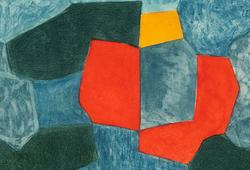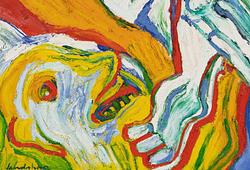Lotte Laserstein
”Ziegen im Stall”.
Signed Lotte Laserstein. Executed around 1934. Oil on paper laid down on panel 65 x 49.5 cm.
Näyttelyt
Skälby gård, Kalmar, ”Mitt liv”, 1983, cat. no 138 som ”Getter i stall”.
Lotte Lasersteins Stiftelse, Kalmar, ”Lotte Lasersteins efterlämnade konstverk”, 1993.
Kirjallisuus
Anna-Carola Krausse, 2006, “Leben und Werk”, oeuvre raisonné in the Werkliste Schweden, no M 1934/18, illustrated p. 99.
Muut tiedot
The auction's work "Ziegen im Stall" executed around 1934, is an example of Lotte Laserstein's artistic practice at a time when her work was characterised by increasingly strict political restrictions. Born in 1898 in Prussian Holland in what was then East Prussia, Laserstein showed her artistic talent at an early age and became one of the first female students at the Berlin Academy of Fine Arts, where she studied between 1921 and 1927. Her painting developed in close dialogue with the German Neue Sachlichkeit movement and is characterised by a pared-down and direct visual language. Laserstein often depicted everyday subjects and portraits, especially of women from her neighbourhood, while her works carried subtle, underlying commentaries on contemporary social and political changes.
Between 1931 and 1935, Lotte Laserstein organized summer retreats to the countryside together with her students. During these trips, nature and rural life were the central themes. In the summer of 1932, one of the trips took place in Neu Sankt Jürgen in Teufelsmoor - an area outside Bremen with a rich artistic tradition. "Ziegen im Stall" likely originates from this period and depicts a calm and tranquil scene of everyday rural life - an image of peace and simplicity. This idyllic portrayal stands in stark contrast to the menacing presence of the rapidly growing nationalist and fascist ideologies that gradually penetrated society.
When the National Socialists took power in 1933, Laserstein's living conditions changed dramatically. Because of her Jewish background, she was excluded from public art institutions, and from 1935 she was forbidden to exhibit, sell artworks or buy materials. Her private teaching activities were also cancelled. Despite these difficult circumstances, she continued to paint with great concentration and integrity, often with subjects drawn from the everyday, but with a subtle protest against the oppression of the time.
"Ziegen im Stall" is one of the works Laserstein created during a period when her artistic freedom was severely restricted. The painting can be interpreted as an expression of the social climate in Germany in the 1930s, where threats and oppression gradually squeezed out artistic freedom.
In 1937, Laserstein was invited to exhibit at Galerie Moderne in Stockholm. This invitation was also the start of her escape from the political situation in her home country. She chose to remain in Sweden, where she later became a Swedish citizen.
In Sweden, Laserstein continued her artistic activity, mainly as a portrait painter but also with flower motifs and other works. After a period of relatively limited interest, her art was revitalised in the late 1980s, leading to several high-profile exhibitions and a renewed appreciation of her life and work.
The major retrospective Meine einzige Wirklichkeit, shown at the Museum Ephraim-Palais in Berlin in 2003, was curated by art historian Anna-Carola Krausse, who has also written a biography of Laserstein. In Sweden, her art has been recognised in exhibitions at Kalmar Art Museum (2004), the Jewish Museum in Stockholm, Bror Hjorths Hus in Uppsala, and in the comprehensive exhibition Lotte Laserstein - A Divided Life at Moderna Museet in Stockholm and Malmö in 2024.
"Ziegen im Stall" invites reflection on the time and conditions that shaped the artist's life and work. The work is an example of Laserstein's ability to retain artistic integrity and expressiveness even under difficult circumstances.




































